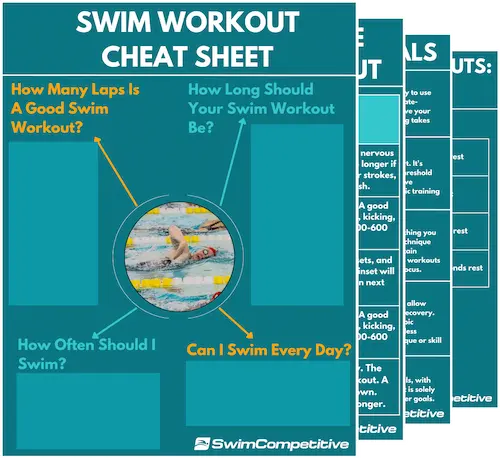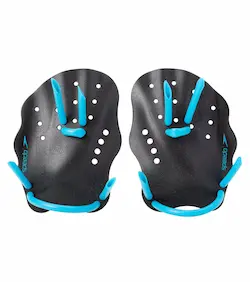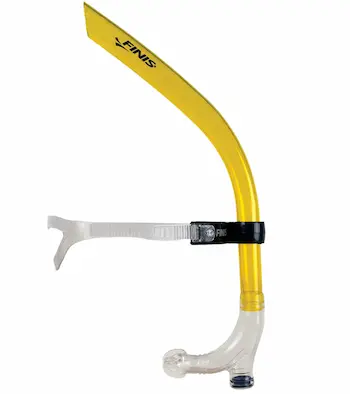Butterfly is one of the most physically demanding strokes in swimming, which is why it’s important to ensure that you are breathing properly and efficiently while swimming it.
Correct butterfly breathing technique won’t only help to supply your muscles with the needed oxygen for executing each stroke and kick with maximal force, but it will also ensure improved efficiency in the water, which can help you to save energy, improve body position, and ultimately swim much faster throughout your race.
That’s why in today’s article we’ll be discussing the butterfly breathing technique. We’ll also be taking a look at the different styles of butterfly breathing, different breathing patterns, some good butterfly breathing drills, as well as some equipment you can use for improving your butterfly breathing technique and becoming a better swimmer.
How to Breathe in Butterfly
In butterfly, the breath is initiated during the pulling phase of the stroke when you take your first kick.
During each cycle of butterfly swimming, you should be kicking twice while performing the butterfly arm movement. The butterfly arm movement can be further broken down into 3 phases, namely the catch, the pull, and the recovery.
The first kick is usually smaller and more explosive. This will help to shoot your arms backward during the pulling phase (which comes after the catch) and to lift your head out of the water, which is when you should breathe.
As your arms start exiting the water, bring your head back down to complete the breathing phase. The most important thing is to bring your head down as soon as possible. Your head should be back in a neutral position before your hands re-enter the water after the arm recovery phase of the stroke. (See photo above).
Make sure to breathe out while your head is underwater during the recovery phase of the arm movement. You can breathe out through your nose or mouth- whichever you find works best for you.
This will ensure that your lungs are empty by the time your head exits the water again, allowing you to breathe air in efficiently and to get your head down faster for the coming strokes as you won’t have to both exhale and inhale while your head is above water during the breathing phase.
A common mistake many swimmers make is lifting the head too high as they exit the water to breathe. This will cause your hips to drop which will break your bodyline creating a lot of drag as well as making the stroke more energy-intensive.
Quick Summary-
- In butterfly, you breathe during the pulling phase.
- The first kick should be smaller and more explosive to propel your head out of the water and your arms backward.
- As soon as your hands exit the water for the recovery phase of the arm movement bring your head back down.
- Try to bring your head down before your hands re-enter the water.
- Exhale while your head is underwater.
- Avoid lifting the head too high when breathing as it will cause your hips to drop creating unnecessary drag.
Here’s a quick video for more visual reference-
The 4 Styles of Butterfly Breathing Technique
1. Traditional Butterfly Breathing Technique
The traditional butterfly breathing technique is probably the more popular breathing technique among competitive swimmers today and requires the swimmer to lift themselves out of the water with their eyes facing forward.
To achieve this the swimmers’ upper-chest must be lifted slightly out of the water creating a higher body position, which will result in more undulation throughout your stroke.
Increased undulation isn’t a bad thing and can be beneficial for creating more momentum as the chest-press will be amplified, causing the hips to pop out slightly more, helping you to maintain a high body position in the water.
This breathing technique is slightly more energy-intensive on the upper body than the chin-skimmer technique which we’ll discuss later. That said, it does offer the benefit of speed if you can maintain it. It’s also one of the best techniques to learn if you are a beginner as it is the most basic.
2. Downward-Angled Butterfly Breathing Technique
The downward-angled butterfly breathing technique is very similar to the traditional butterfly breathing technique used by most swimmers today. This breathing technique also requires the swimmer to lift their upper chest slightly out of the water as they come up to take a breath.
The difference here, however, is that instead of looking forward the head is tilted at a slight angle of around 30°-45° so that the eyes are facing the water instead of looking straight ahead at the wall on the other side of the pool.
The benefit to this compared to the traditional butterfly breathing technique is the fact that it’s easier to maintain a high hip position as you start to get tired. When looking directly forward (as in the traditional breathing technique), the hips tend to drop more when your stroke starts to fall apart near the end of your race.
This technique is slightly more complicated and some swimmers may feel like they aren’t able to grasp quite as much air. That said, this is probably one of the faster butterfly breathing techniques and it’s also quite popular among professional swimmers.
3. Chin Skimmer Butterfly Breathing Technique
The chin skimmer butterfly breathing technique was popularized by the world-famous Olympic swimmer, namely Michael Phelps. This technique requires the swimmer to maintain a very flat body position with the neck simply extending forward when you take a breath while your chin skims across the surface of the water.
The benefit of this breathing technique is that you’ll be able to breathe very fast without creating much of a change in your body position as the neck is simply extending up and down. This is why, unlike many other swimmers, Michael Phelps was able to breathe every stroke during his 100 and 200 butterfly events.
This butterfly breathing technique is harder to master and to maintain throughout a race since it requires you to have a very strong kick, hence why not as many swimmers use it. That said, if you are a more advanced swimmer, you can give this breathing technique a go to see if it works for you.
4. Side Breathing Butterfly Technique
The side breathing butterfly technique is an older breathing style that isn’t very popular nowadays. This technique was quite popular back in the 1990s and early 2000s, where the idea was to keep the swimmer closer to the surface of the water to achieve a faster and higher tempo stroke.
Some swimmers may find this more comfortable, but in general, this probably isn’t going to be your best option. As mentioned, the flatter stroke will require you to have a very strong kick. This breathing technique also requires a lot of shoulder and neck flexibility and may cause additional drag as you move your head back into a neutral position after taking a breath. (Since it will be pushing sideways against the water).
That said, there are still a few swimmers on the world stage using this breathing technique, particularly in the 200 butterfly events.
Do You Want to Make Every Lap Count?
Stop wasting your time in the pool feeling lost and doing directionless swim workouts, and start training effectively! Our ebook contains 97 structured and goal-orientated swim workouts to help you become a better, faster, and fitter swimmer. Whether you’re a complete beginner or a seasoned pro, there are a multitude of workouts for every type of swimmer.
Which Butterfly Breathing Style Should You Use?
In general, I recommend using the downward-angled butterfly breathing technique. This is similar to the traditional breathing technique in terms of your body position but does offer a slightly more efficient stroke which will help you to swim faster.
That said, you have to experiment and find what works best for you. Some swimmers may see more benefit in the traditional breathing technique while others may be able to perform and maintain the chin-skimmer technique efficiently.
Also, don’t be afraid to change up your breathing technique as you become a more advanced and experienced swimmer.
Butterfly Breathing Patterns
Learning to use a breathing pattern when you swim butterfly is an important aspect of becoming a better and faster swimmer in the pool. There are a couple of different breathing patterns that you can use while swimming butterfly.
Every time you breathe your hips will slightly drop as you lift your head. This breaks your body position and creates drag. The less you breathe, the better you’ll be able to maintain a high body position in the water while also staying within your body line.
Breathing Every Stroke
Generally, you should only be breathing every stroke if you use the chin-skimmer butterfly breathing technique or are a beginner. Breathing every stroke can also be used for longer events such as the 200 fly. (I personally use this breathing pattern for the 200 fly).
1 Up, 1 Down
This is a popular breathing technique that combines both speed and efficiency while allowing the swimmer to have a constant supply of air. This is the breathing pattern used by the current 100m butterfly world-record holder, namely Caeleb Dressel.
1 Up, 2 Down
This breathing pattern is one of the most popular among swimmers. It allows the swimmers to find the perfect balance between speed and efficiency while still allowing enough air intake to maintain a fast stroke.
1 Up, 3 Down
The 1 up, 3 down breathing pattern is slightly less popular but offers great benefit if you can maintain it. That said, most swimmers are going to have a hard time maintaining this breathing pattern over anything longer than a 50.
No Breath
Not breathing at all is typically used for short 50 sprints. This is the fastest way to swim, as you’ll maintain an almost perfect body position throughout the entire race. That said, this technique should only be used by advanced swimmers and takes a lot of training to maintain throughout a race.
Related: Best tech suits for butterfly swimmers.
Butterfly Breathing Technique Drills
1. Butterfly Standing Breath Timing Drill
The butterfly standing breath timing drill is a simple drill that swimmers can perform on the shallow end of the pool. This drill is easy to perform and doesn’t require much energy.
The purpose of this drill is to teach swimmers proper breath timing which is critical for swimming butterfly efficiently. This drill can also be used to teach proper hand entry in the butterfly stroke.
How to perform this butterfly drill-
- Find somewhere in the pool where you can comfortably stand with your feet shoulder-width apart so that your upper body is just above the water.
- Start with your hands behind your hips and bring them over in the recovery phase of the arm movement.
- Your pinky-fingers should exit the water first and your thumbs pointed down as your arms come over the water.
- Your hands should enter the water roughly shoulder-width apart. Make sure that your hands enter the water with your middle fingers first and not your thumbs as this will delay the time it takes for your hands to enter into the catching phase of the arm stroke.
- You should be breathing when your hands pass your shoulders during the pulling phase of the stroke.
- Your head should start to re-enter the water as your hands exit the water.
- Make sure that your head is back in the starting position before your hands have re-entered the water for the catching phase of the stroke.
2. Butterfly Body Position Kick Breathing Drill
The butterfly body position kick breathing drill is another simple drill to teach the up-and-down movement pattern of the head when swimming butterfly as well as helping you to become comfortable with the kick if you aren’t already.
Additionally, it will also teach you the basic timing of the breath in the butterfly stroke and will also help you to learn a good butterfly body position. This drill also doesn’t require much energy to perform.
How to perform this butterfly drill-
- Start by performing a butterfly kick on your front with your hands by your side.
- Every 2 kicks lift your head just out of the water and take a breath.
- It’s important to breathe every 2 kicks as this is simulating one cycle of butterfly swimming, which will teach basic timing.
- You can also breathe every 4 or 6 kicks which will simulate longer breathing patterns such as the 1 down, 1 up or 2 down, 1 up breathing pattern.
- Once you are comfortable performing this drill with your hands by your sides, you can place them in front of you shoulder-width apart to make the drill more advanced as you’ll be simulating the butterfly body position more accurately.
3. Butterfly Push Through Drill with Breath Focus
The butterfly push through drill is a popular butterfly drill among competitive swimmers. This drill is great for developing power during the kick and pull phase while teaching you how to perform the catching phase for maximal efficiency. It can also be adapted to focus on the breathing style.
How to perform this butterfly drill-
- Start by placing both arms in front of you and performing a steady butterfly kick.
- Do some basic sculling to get a feel for the water.
- When you’re ready, pull your arms down into the catching phase.
- From there give a strong butterfly kick, coupled with the pulling phase of the arm stroke.
- As the kick starts and you start pulling, shoot your head out of the water.
- This is the part where you practice the breathing style of your choice, for example- downward-angled butterfly breathing.
- After completing this explosive movement, take some time to recover while doing light freestyle or breaststroke kicking as you bring your arms back to the front.
- You should be able to repeat this movement 3-4 times throughout a 25m distance.
Butterfly Training Aids for Improving Breathing Technique
Swimming Fins
Swimming fins can be used to add power to your stroke, which will make swimming butterfly easier. This will allow you to focus on your breathing style and pattern without having to worry as much about the actual swimming of the stroke.
If you require some good fins, I recommend the Arena Powerfin Pro.
Quick summary: The Arena Powerfin Pro is a premium swimming fin made from durable 100% silicone material. Its short inclined blade and hydrodynamic slits enable high-frequency kicking, improving leg strength and power.
Additional cuts on the bottom increase kick power. The open-heel design maximizes ankle flexibility, providing a comfortable fit.
Paddles
Similar to fins, paddles can also be used to add more power to your stroke helping you to focus more on your butterfly breathing technique. You may also choose to combine paddles and fins for maximal power output.
That said, when using equipment such as fins and swimming paddles you’ll have to pull more water which can tire you out.
That’s why I recommend breaking things down over shorter distances. For example, you can do a set of 20x25s on 0:45 (or longer if you need it) with fins and/or paddles with the focus on your breathing. You can also do say a 25 swim and then a 25 drill to give yourself some time to rest.
For paddles I recommend the Speedo Nemesis Contour Paddles.
Quick summary: The Speedo Nemesis Contour Swim Paddle is suitable for all swimmers and has a unique contoured design for an enhanced feel for the water and correct hand entry.
The scalloped edges increase water resistance and facilitate natural pulling for technique and power. Additional features include adjustable straps, holes for water flow, and three size options.
Snorkel
Unlike fins and paddles, the snorkel can be used to eliminate the breathing technique from your stroke and to solely focus on the swimming technique. The benefit of using a snorkel, however, is that it will help you to develop strong lungs which can help you to maintain a more advanced breathing pattern when swimming butterfly.
The snorkel used in combination with swimming fins and/or paddles can make for a great butterfly conditioning set.
Here is a quick example-
- 15x100s fly on 2:00 (can be on a slower interval as well).
- First 25- body position butterfly kick.
- Middle 50- butterfly swim.
- Last 25- butterfly drill.
If you don’t yet have a snorkel, 2 of my favorite options include the Finis Swimmer’s Snorkel and the Arena Swim Snorkel 2.
Improve Your Butterfly Breathing Technique to Swim Faster
Proper breathing is a key element of successfully swimming butterfly. Not only will it ensure that your muscles are receiving enough oxygen, but it also plays a critical role in maintaining an efficient body position throughout your stroke.












